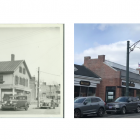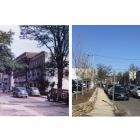There & Then
New Canaan Now & Then: Cody Pharmacy
|
Samuel Silliman opened the first drug store in New Canaan on Main Street in 1845. Nine years later, Lucius Monroe purchased it and renamed it the New Canaan Drug store. Doctors came to dispense medicines and Monroe did, too. By the later part of the 19th century, the drug store had become something of a social center of the town. It had a soda fountain with a marble counter, home-made ice cream, round ice cream parlor tables and chairs, hair oil for men, women’s cosmetics, mortars and pestles, Magic Hoodoo Ant Paper, various powders and fragrances, bottles, stuffed birds, jars of rock candy and licorice, cigarettes, cigars, snuff, school supplies, and toilet paper.




